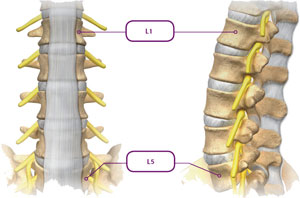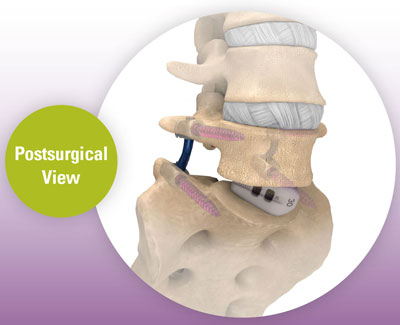Maximum Access Surgery (MAS®) Transforaminal Lumbar Interbody Fusion (TLIF)
About the Lumbar Spine
The area of your spine in your lower back is called the lumbar spine. It is made up of five bones, called vertebrae. These vertebrae are connected by several joints, which allow you to bend, twist, and carry loads. The main joint between two vertebrae is called a disc. The disc is comprised of two parts, a tough and fibrous outer layer (annulus fibrosis), and a soft, gelatinous center (nucleus pulposus). These two parts work in conjunction to allow the spine to move, and also provide shock absorption.

Front and side views of the lumbar spine
What is causing my pain?
There are several primary causes of spine problems. The majority of the symptoms are caused by disc, bone, or ligaments pressing onto the nerve roots.
DEGENERATIVE DISC DISEASE (DDD)
During the natural aging process, the discs between each vertebral body can lose their flexibility, height, and elasticity which can cause a tear in the tough outer layer of the disc, causing the disc to herniate, bulge or leak the gelatinous core. The bulges or leakages can end up compressing the nerve roots and/or spinal cord, causing symptoms including, but not limited to lower back and/or leg pain.
What are my treatment options?
Many of the symptoms can be treated without surgery with methods that involve medication, rest, heat, and physical therapy. It is important that you speak to your physician about the best options for you.
If your symptoms do not improve with other methods, your physician may suggest spinal surgery. Surgery is reserved for those who do not gain relief from non-operative forms of treatment, patients whose symptoms are increasing or worsening, and/or patients that present with a spinal condition which indicates the need for surgery.
What is a MAS® TLIF procedure?
Lumbar interbody fusion is a surgical technique that attempts to eliminate instability in the back. A MAS TLIF achieves this by using a less invasive approach to fuse one or more vertebrae together to reduce their motion.
In a MAS TLIF procedure, rather than starting from the middle of the back and spreading the muscles to the sides like in a traditional back surgery, the MAS® TLIF approach starts off to one side of the back and splits (rather than cuts) the back muscles in one direction. This allows the surgeon to make a smaller incision with less muscle injury, which may result in less postoperative pain and a quicker recovery.
What Are The Potential Advantages MAS® TLIF?
- Reduced blood loss and minimal scarring
- Reduced hospital stay
- Faster postoperative recovery time
- Smaller incision
Is a MAS TLIF right for me?
Your physician might determine a MAS TLIF procedure is a good option for you if you require a spinal fusion at any lumbar level between L1 and S1, and you would benefit from a less disruptive approach.
Conversely, your physician may determine that a MAS TLIF procedure is not a good option for you. It is important to discuss this with your physician.
Are there risks involved?
All surgery presents risks and complications that are important to discuss with your physician prior to your surgery. Listening to your physician’s guidance, both before and after surgery, will help to ensure the best possible outcomes from your procedure.
Some of the most common complications following MAS TLIF surgery include: problems with anesthesia, infection, nerve damage, problems with the graft or hardware, and ongoing pain. This is not intended to be a complete list of the possible complications.
What can I expect...?
Before surgery
Your physician will review your condition and explain all of your treatment options, including non-operative treatments, such as medications and physical therapy. Once you have been admitted to the hospital, you will be taken to a pre-op room and prepared for surgery. This may include instruction about the surgery, cleansing of your surgical site, as well as instruction about the postoperative period.
What happens during surgery?
SURGICAL PROCEDURE
After you are positioned on your belly and draped, an x-ray is taken of your spine to show the location of the operative disc space.
Step:1
APPROACH
Typically, your surgeon will make a small incision on one side of your back. The size of the incision can vary based on the number of levels and/or complexity of your case.
Step:2
DISC REMOVAL
Your surgeon will then remove the disc to reduce pressure from the symptomatic cord or nerve root. An appropriate implant, chosen by your surgeon, will be placed into the disc space to restore the proper disc height and provide mechanical support while bone grows between the vertebral bodies during the fusion (bone healing) process. That segment of your spine will eventually stabilize once fusion occurs.
What implants are used?
Below are some examples of implants that may be used during your MAS® TLIF procedure:

During surgery
Step:3
IMPLANT
Screws will be placed into the vertebrae to provide stabilization to the spine. Once the screws have been placed on the MAS® TLIF side, screws are also inserted on the opposite side of the vertebrae through one or two small skin incisions. These screws provide additional stability to help hold everything in place while fusion occurs. They are inserted through a small, minimally disruptive incision.
Step:4
FIXATION
The final result will be a construct with an interbody implant between the vertebral bodies, where the fusion will occur, and screw and rod fixation on both sides to stabilize.

What can I expect...?
After surgery
Patients usually require a stay of 1-2 days in the hospital. Your physician will discuss what is right for your particular case. The day after your surgery, your physician may instruct you to use a brace for a period of time to assist with the spinal fusion process. Supervised by trained medical professionals, your physician may ask you to carefully sit, stand, or walk within 24 hours of the surgery.
Once you are discharged from the hospital it is important to limit your activities for a period of time (determined by your healthcare provider) to give your body a chance to heal. Your physician will provide instructions on wound care, exercises, and limitations to postoperative activity.
Frequently asked questions
CAN I SHOWER AFTER SURGERY?
Depending on your surgical incision, you may have showering restrictions. Ask your physician for appropriate instructions.
WILL I HAVE A SCAR?
Your physician will discuss the incisions that will be made during your MAS® TLIF surgery. Small scars of approximately one and a half inches are common.
WHEN CAN I DRIVE?
For a period of time after your surgery, you may be cautioned about activities such as driving. Your physician will tell you when you may drive again.
CAN I TRAVEL?
The implants used in the MAS TLIF procedure may activate a metal detector. Because of increased airport security measures, please call your local airport authority before traveling to get information that might help you pass through security more quickly and easily. Ask your physician to provide a patient identification card.
Note: The information and image included herein is the property of www.nuvasive.com
